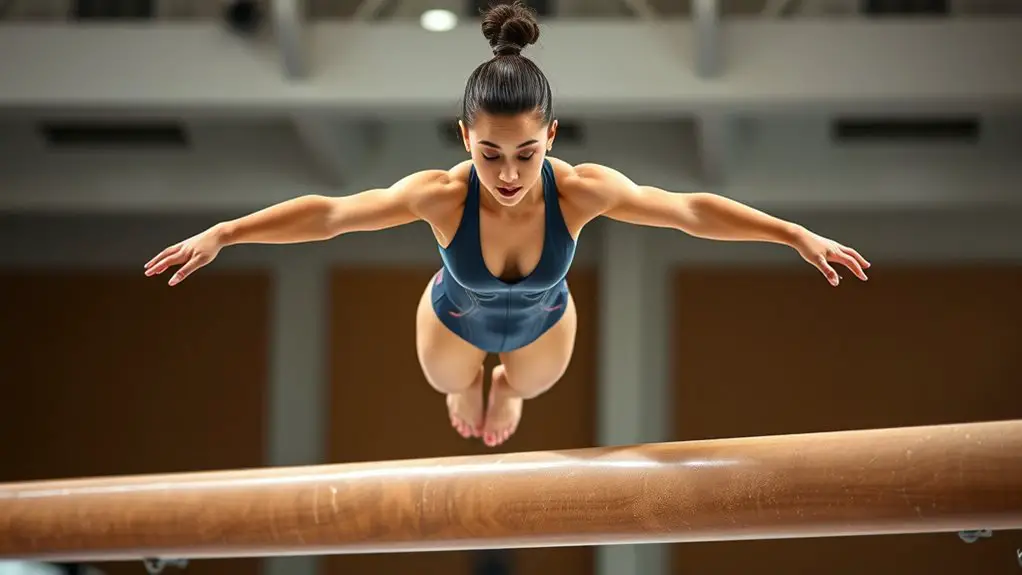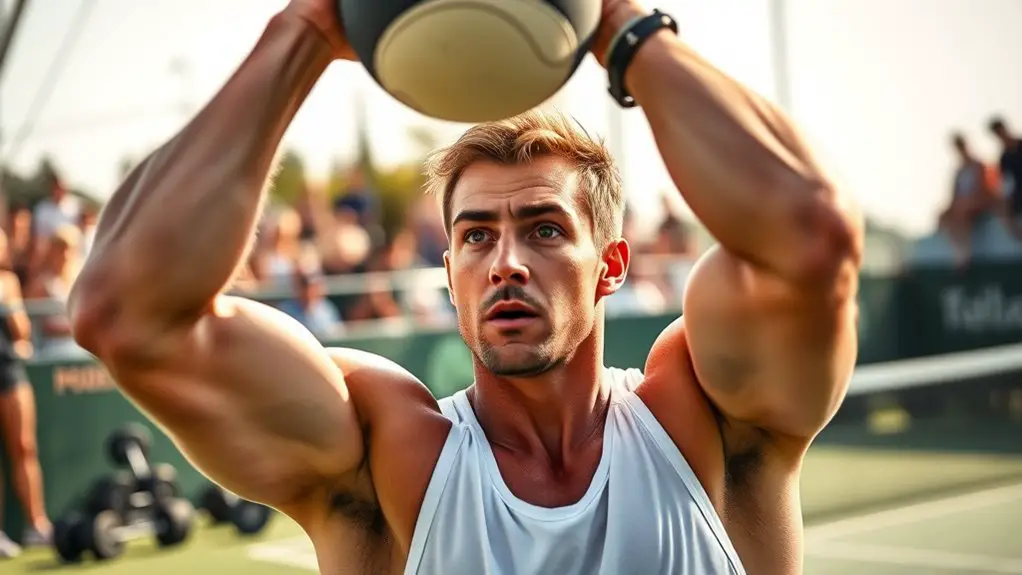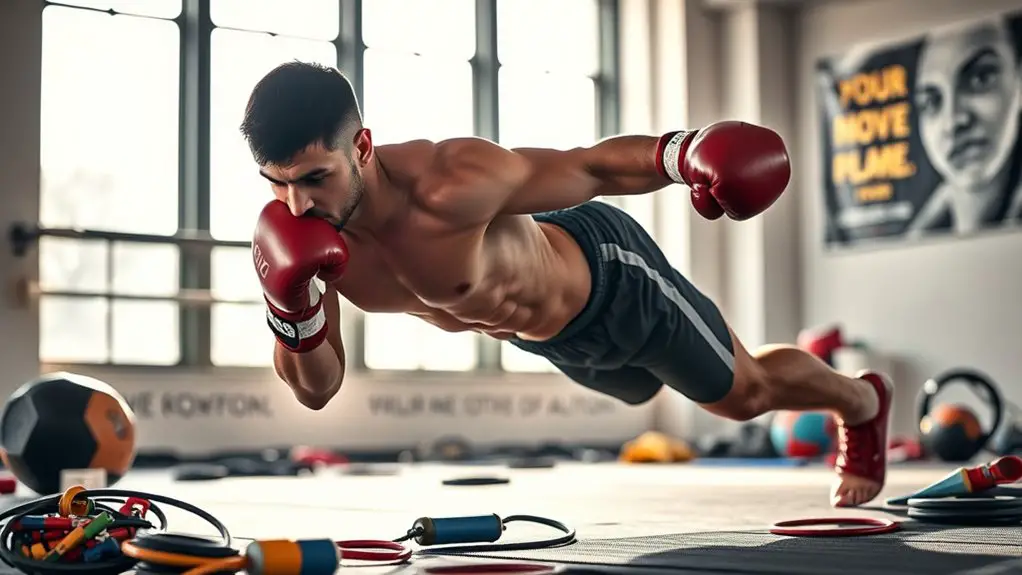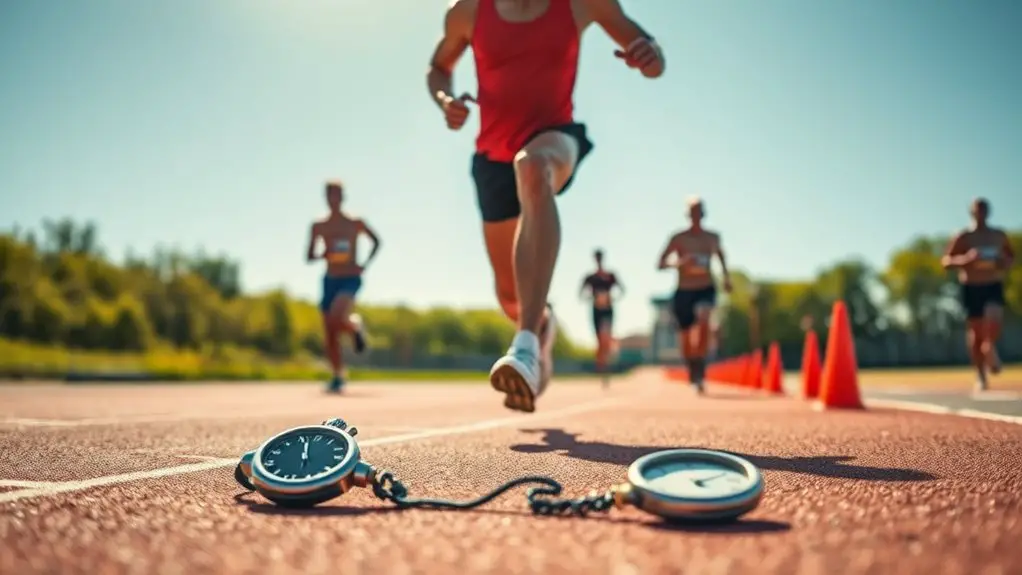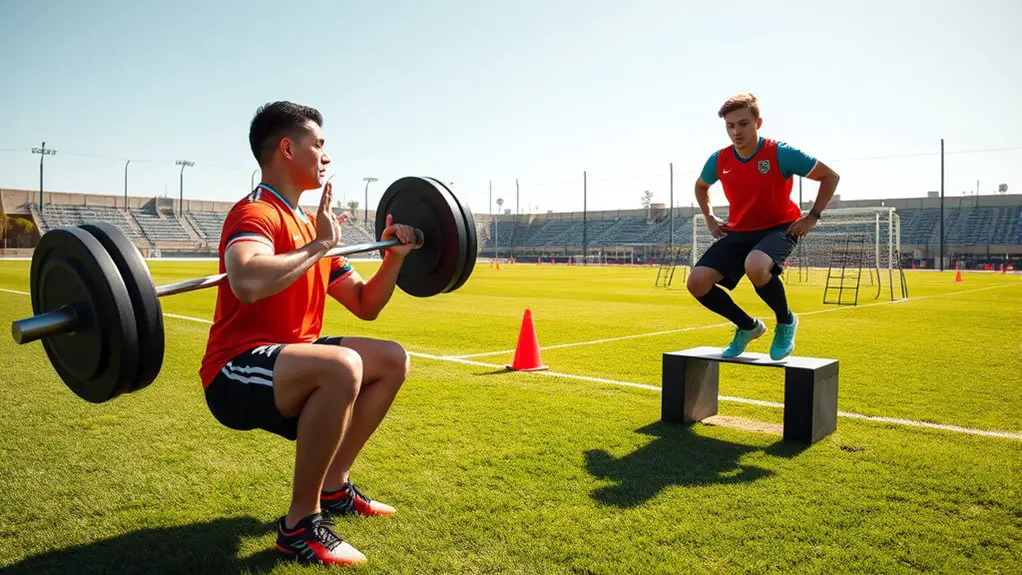Core strength is essential for your gymnastics performance, as it directly affects your balance, stability, and power during routines. A strong core helps you maintain proper alignment, reducing the risk of injury and enhancing precision in your movements. It also fosters confidence, allowing for more graceful execution of skills. By integrating core workouts into your training, you can elevate your performance even further. Discover just how transformative core strength can be for you.
Understanding Core Strength and Its Importance
Core strength is the foundation of a gymnast's performance, influencing everything from balance to power. You might not realize it, but having a strong core allows you to move more freely and confidently in your routines. It's that invisible force that keeps you stable during flips and turns, enabling you to express your artistry without fear of losing control.
When you engage your core, you create a solid base for all your movements. You'll find that your skills improve, whether you're on the balance beam or the floor. This strength not only enhances your physical abilities but also boosts your mental focus, allowing you to perform with grace and poise. A strong core stabilizes the body during powerful movements, helping you maintain control and precision throughout your routines.
In gymnastics, every move counts, and your core plays a critical role in how well you execute them. Embracing core strength means embracing a greater sense of freedom in your performance.
The Anatomy of the Core Muscles
To truly understand core strength, you need to know the major muscle groups involved. These muscles work together to provide stability and power during your gymnastics routines. Let's explore how each muscle contributes to your overall performance. Additionally, enhanced flexibility plays a crucial role in maximizing your core strength and overall athletic performance.
Major Core Muscle Groups
The foundation of impressive gymnastics performance lies in the strength of key muscle groups that make up the core. You've got your rectus abdominis, often called the "six-pack," which helps with flexion and stability. The obliques, both internal and external, are vital for twisting and lateral movements, giving you that fluidity in routines. Don't forget about the transverse abdominis; it acts like a natural corset, stabilizing your spine and pelvis. The erector spinae runs along your back, supporting posture and balance. Finally, the diaphragm and pelvic floor muscles are essential for breathing and core stability. By strengthening these muscle groups, you'll reveal your potential, enhancing not just your performance, but your overall freedom in movement.
Core Muscle Functionality
Understanding how core muscles function is essential for any gymnast aiming to enhance their performance. Your core isn't just about abs; it's a complex network that stabilizes your entire body. Here's what you need to know:
- Stability: Core muscles support your spine, preventing injury during intense routines.
- Balance: A strong core helps maintain equilibrium, vital for executing difficult maneuvers.
- Power: Core strength generates force, translating into more explosive movements like jumps and flips.
- Coordination: Well-functioning core muscles improve overall body control, enhancing your precision.
How Core Strength Affects Balance and Stability
While many factors contribute to a gymnast's performance, core strength plays a pivotal role in maintaining balance and stability. Your core muscles act like a solid foundation, anchoring your body as you execute complex moves. When you've got a strong core, you're better equipped to control your center of gravity, which is essential for staying upright and steady on the balance beam or during floor routines.
Imagine performing a flip or a handstand; it's your core that helps you keep everything aligned and prevents you from tipping over. A well-developed core allows for more precise movements, giving you the freedom to express yourself without the constant worry of losing your balance. With each practice, you're not just building strength but also enhancing your ability to flow through routines with grace and stability. Emphasizing core strength can truly elevate your gymnastics game, allowing you to perform with confidence. Additionally, incorporating mobility training into your routine can further enhance your overall performance and stability.
The Connection Between Core Strength and Power
Core strength isn't just about stability; it also greatly influences your power during performances. When you harness your core, you're releasing a force that translates into explosive movements, allowing for more dynamic routines. A strong core acts as a powerhouse, connecting your upper and lower body, which enhances your overall athleticism.
Here are some key benefits of core strength for power:
- Improved Force Transfer: Efficiently transmit energy through your body.
- Enhanced Speed: Generate quick, powerful movements with ease.
- Greater Control: Maintain precision in your techniques, even under pressure.
- Increased Endurance: Sustain power throughout your routine without fatigue.
- Support for Olympic lifts: These lifts require core engagement to optimize performance and help in achieving athletic goals.
Core Strength's Role in Injury Prevention
A strong core can greatly reduce your risk of injury in gymnastics. When your core is stable, it supports your spine and helps maintain proper alignment during routines. This means you're less likely to strain muscles or joints when performing complex maneuvers. With a solid core, you'll find it easier to control your body, which leads to more precise movements and fewer awkward landings that could result in injury.
Additionally, a well-developed core enhances your balance and coordination, further protecting you during practice and competition. You'll feel more confident as you execute flips, twists, and turns, knowing your body's supported. By prioritizing core strength, you're not just improving performance; you're empowering yourself to express your skills freely and safely. Remember, a strong core is your foundation for preventing injuries and enjoying the art of gymnastics to its fullest! Furthermore, incorporating Functional Movement Screening into your training can help identify areas of weakness that may benefit from additional core development.
Essential Core Exercises for Gymnasts
To excel in gymnastics, incorporating essential core exercises into your training routine is vital. A strong core not only enhances your performance but also supports your freedom of movement. Here are some key exercises to include:
- Planks: Engage your entire core, improving stability.
- Hollow holds: Develop strength and control in your midsection.
- Russian twists: Build rotational strength for better shifts.
- Leg raises: Strengthen your lower abs for powerful takeoffs.
These exercises will help you achieve the core strength needed for dynamic routines and maintain balance during complex maneuvers. Remember, the freedom to express your skills comes from a solid foundation. By focusing on these core exercises, you'll not only elevate your performance but also reduce the risk of injury. So, embrace the challenge and make these essential exercises a part of your journey toward gymnastics excellence!
Incorporating Core Training Into Gymnastics Routines
Incorporating core training into your gymnastics routines can really enhance your performance. You'll find that integrating essential core exercises not only strengthens your body but also improves your balance and coordination. As you work on these skills, you'll experience the benefits that come with a strong core, setting you up for success in your routines. Additionally, focusing on core stability and strength will significantly contribute to your overall athletic performance.
Essential Core Exercises
Core strength is fundamental for gymnasts, as it supports nearly every movement and skill in their routines. Incorporating specific core exercises can help you build the stability and power needed to excel. Here are some fundamental core exercises you should consider:
- Planks: Strengthen your entire core while improving your balance.
- Hollow Holds: Develop overall body tension, essential for maintaining form in the air.
- Leg Raises: Target your lower abs, crucial for flipping and twisting skills.
- Russian Twists: Enhance rotational strength, important for dynamic movements.
Integrating Core Workouts
Success in gymnastics hinges on a strong core, making it essential to weave core workouts seamlessly into your training routine. Start by incorporating core exercises into your warm-ups; planks, leg raises, and Russian twists can energize your session. As you progress, integrate core strength drills into your skill practice. For instance, while working on vaults or bar routines, focus on maintaining core engagement to improve stability and control. You can also add core-focused circuits on your off days, allowing your body to recover while still building strength. Remember, the key is consistency. By making core workouts a natural part of your gymnastics training, you'll enhance your performance and enjoy the freedom of movement that comes with a strong core.
Benefits for Gymnasts
While many gymnasts focus on flexibility and strength, adding core training to your routine can greatly enhance overall performance. A strong core not only supports your movements but also boosts your confidence on the mat. Here are some key benefits of incorporating core workouts:
- Improved Balance: A solid core helps stabilize your body during complex maneuvers.
- Enhanced Power: Core strength translates into more explosive movements, like jumps and twists.
- Injury Prevention: Stronger core muscles protect your spine and reduce the risk of injuries.
- Better Control: You'll have greater control over your body, allowing for precision in routines.
Embracing core training can set you free to express your artistry and athleticism in gymnastics!
Measuring Core Strength Progress in Gymnasts
How can you effectively gauge the progression of core strength in gymnasts? You'll want to focus on both qualitative and quantitative measurements. Consider using specific tests that can track improvements over time. Here's a simple way to organize your observations:
| Measurement Tool | Frequency |
|---|---|
| Plank Hold Duration | Weekly |
| Leg Raises (Reps) | Biweekly |
| Hollow Body Hold | Monthly |
| Medicine Ball Throws | Biweekly |
| Core Stability Tests | Monthly |
This approach allows you to monitor changes in endurance, strength, and stability. You can also take note of how gymnasts feel during their routines; subjective feedback is essential. By keeping a record, you'll not only see tangible progress but also foster a sense of empowerment in the gymnasts as they witness their own growth. Embracing this method gives them freedom to explore their capabilities.
The Impact of Core Strength on Artistic Performance
Core strength profoundly influences artistic performance in gymnastics, as it serves as the foundation for balance, control, and fluidity in movement. When you enhance your core, you're not just building muscles; you're revealing your potential to express freedom in every routine.
- Improved Balance: A strong core stabilizes your body, allowing for precise landings and shifts.
- Enhanced Control: With core strength, you can execute complex maneuvers without losing your form.
- Fluid Movement: A stable core helps create seamless shifts, making your routines appear effortless.
- Increased Confidence: Feeling strong in your core translates to confidence, empowering you to take risks with your performance.
Embracing core training is about more than just physicality; it's about freedom. When your body feels strong and capable, you can fully express your artistry on the mat, enchanting your audience and elevating your performance. Additionally, strong core stability enhances proprioceptive abilities, allowing for better movement awareness and injury prevention.
Success Stories: Gymnasts Who Prioritized Core Training
Many elite gymnasts have transformed their performances by prioritizing core training, demonstrating its undeniable impact on their success. You might find inspiration in their stories, as they emphasize the importance of a strong core in achieving freedom of movement and expression in gymnastics. Core strength not only enhances balance for fluid movement but also allows for full expression of potential during routines.
| Gymnast | Core Training Focus |
|---|---|
| Simone Biles | Dynamic core stability |
| Aly Raisman | Core strength endurance |
| Shawn Johnson | Flexibility and control |
| Nastia Liukin | Balance and alignment |
| Kohei Uchimura | Power and explosiveness |
These athletes show that when you commit to strengthening your core, you open doors to greater agility, precision, and artistry. Their remarkable journeys remind you that investing in core training can lead to personal breakthroughs, helping you to soar to new heights in your own gymnastics endeavors.
Frequently Asked Questions
How Does Diet Influence Core Strength in Gymnasts?
Your diet directly affects your core strength. Eating nutritious foods fuels your workouts, helps build muscle, and aids recovery. When you nourish your body properly, you're more likely to perform at your best.
Can Core Strength Training Improve Mental Focus During Performances?
You might not realize it, but building core strength can sharpen your mental focus during performances. When your body's stable, your mind can concentrate better, freeing you to execute routines with confidence and clarity.
What Age Should Gymnasts Start Core Strength Training?
You can start core strength training for gymnasts around age 6 or 7. At this age, their bodies are developing, and introducing core exercises can enhance overall stability and performance while keeping it fun and engaging.
Are There Specific Warm-Up Exercises for Core Strength?
You can try planks, Russian twists, and leg raises to warm up your core. These exercises'll help activate your muscles, improve stability, and enhance overall performance, keeping you feeling free and strong during practice.
How Often Should Core Strength Training Be Incorporated Weekly?
You'll find that embracing core strength training two to three times a week opens doors to greater freedom in movement. It's all about balance, allowing your body to thrive without feeling restricted or overwhelmed.
